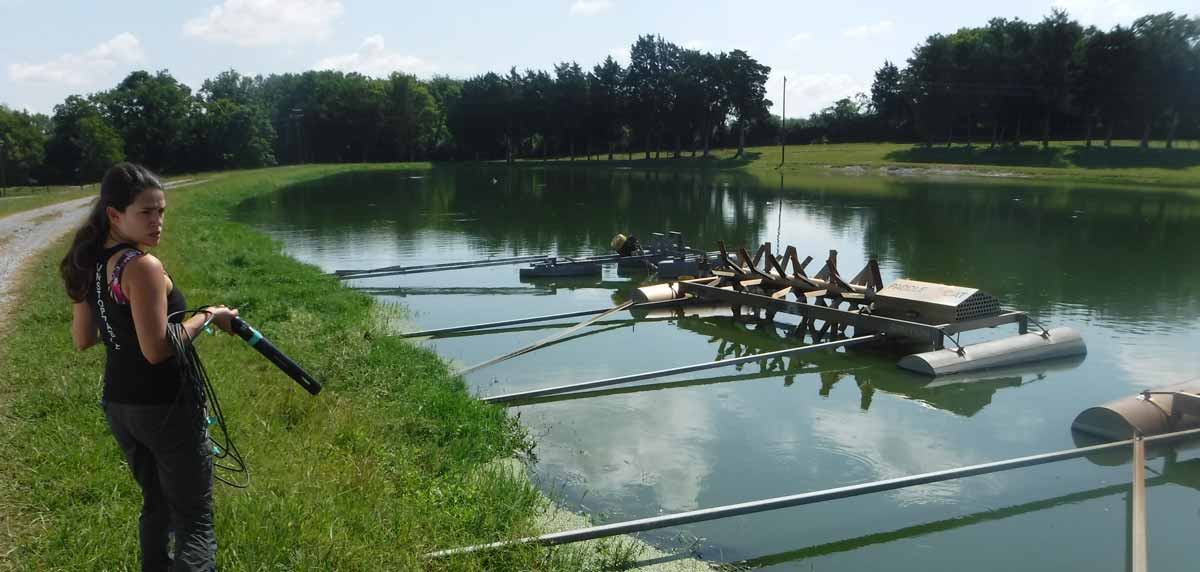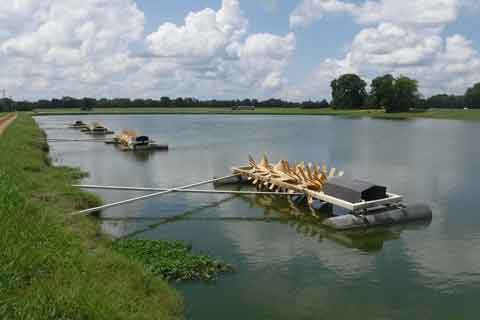
Research Areas
Aquacultural Advancements

Bacterial-algal-zooplankton process for conversion of agricultural waste into aquaculture feed.
Current Projects
Chemical strategies to control algal bloom & support sustainable aquaculture growth & development
Funding: USDA - Agricultural Research Service - $578,871
June 2023 - May 2028
Benjamin Beck (USDA ARS), Tham Hoang (Auburn University), Luke Roy (Auburn University), and Anita Kelly (Auburn University)
Elucidating phosphorus loading and bioavailability in catfish ponds for sustainable aquaculture
Funding: AAES ARES – AgR SEED Grant program - $50,000
September 2022 - August 2024
Dengjun Wang (PI, Auburn University)
Harmful algal blooms: Prevalence and control measures for the domestic fish and shellfish industries
Funding: USDA - Agricultural Research Service - $2,088,566
June 2020 - May 2025
Benjamin Beck (USDA ARS)
Dimensions of Biodiversity: Collaborative Research: Phylogenetic, genetic, and functional diversity of the cyanobacterial bloom interactome from local to global scales
Funding: National Science Foundation (Dimensions of Biodiversity program) - $1,999,994
August 2018 - September 2024
Dave Hambright (OU PI) and Lee Krumholz (co-PI) (University of Oklahoma), Hans Paerl (UNC PI, University of North Carolina at Chapel Hill), and Morgan Steffen (JMU PI, James Madison University)
Past Projects
Toxic cyanobacterial blooms and fish farming
Funding: Auburn University Agricultural Experimental Station - $54,650
October 2007 - September 2008
Jesse Chappell (co-PI, Auburn University)
Creating a tool for forecasting harmful algal blooms using earth observations and machine learning to predict (HELP) high risk surface water sources
Funding: AAES AgR-SEED program - $149,546
September 2021 - August 2023
Stephanie Rogers (PI, Auburn University), Yin Bao (co-PI, Auburn University), and Edna Fernandez-Figueroa (co-PI, Auburn University)
Publications
- Bagherian, K, E. G. Fernández-Figueroa, S. R. Rogers, A. E. Wilson, and Y. Bao. 2024. Predicting chlorophyll-a concentration and harmful algal blooms in Lake Okeechobee using time-series MODIS satellite imagery and long short-term memory. Journal of the ASABE.
- Wang, D., A. K. Hamid, I. M. Radwan, A. E. Wilson, H. A. Torbert, and B. H. Beck. 2024. Understanding how phosphorus could be removed in aquaculture ponds by gypsum. Alabama Fish Farming Center 1:12-13. - Dowload Publication (PDF)
- Gladfelter, M. F., A. V. Hennessey, M. B. McDonald, S. S. Ganegoda, D. Wang, and A. E. Wilson. 2024. Are heavy metals a concern in catfish aquaculture? Alabama Fish Farming Center 1:10-12. - Dowload Publication (PDF)
- Baylous, H. R., M. F. Gladfelter, M. I. Gardner, M. Foley, A. E. Wilson, and M. M. Steffen. 2024. Indole-3-acetic acid promotes growth in bloom-forming Microcystis via an antioxidant response. Harmful Algae 133:102575 - Link to Publication
- Zinnert, H. M., M. F. Gladfelter, S. E. Tenison, H. P. Poe, K. L. Merrill, A. V. Hennessey, M. B. McDonald, D. Wang, H. A. Torbert, and A. E. Wilson. 2024. Impacts of flue gas desulfurization (FGD) gypsum on water quality and the algal community in catfish aquaculture ponds. Aquaculture 581:740406. - Link to Publication
- Zinnert, H. M., M. F. Gladfelter, H. P. Poe, K. L. Merrill, A. V. Hennessey, M. B. McDonald, D. Wang, H. A. Torbert, and A. E. Wilson. 2023. Positive and negative impacts of flue gas desulfurization (FGD) gypsum on water quality. Journal of Environmental Management 348:119307. - Link to Publication
- Hamid, A., A. E. Wilson, M. F. Gladfelter, T. J. Knappenberger, and D. Wang. 2023. Long-term missing role of colloids and nanoparticles on the loading and speciation of phosphorus in catfish aquaculture ponds in west Alabama. Chemosphere 340:139906. - Link to Publication
- Li, S., F. Wei, X. Dong, M. Pan, L. Li, X. Tian, Q. Gao, and A. E. Wilson. 2023. Shift of phytoplankton and microbial communities cause seasonal dynamics of odor compounds in Oncorhynchus mykiss cultured in a freshwater reservoir. Aquaculture 570:739422. - Link to Publication
- Hamid, A., A. E. Wilson, H. A. Torbert, and D. Wang. 2023. Sorptive removal of phosphorus by flue gas desulfurization gypsum in batch and column systems. Chemosphere 320:138062. - Link to Publication
- Buley, R. P., M. F. Gladfelter, E. G. Fernandez-Figueroa, and A. E. Wilson. 2023. Complex effects of dissolved organic matter, temperature, and initial bloom density on the efficacy of hydrogen peroxide to control cyanobacteria. Environmental Science and Pollution Research 30:43991-44005. - Link to Publication
- Buley, R. P., M. F. Gladfelter, E. G. Fernandez-Figueroa, and A. E. Wilson. 2022. Can correlational analyses help determine the drivers of microcystin occurrence in freshwater ecosystems? A meta-analysis of microcystin and associated water quality parameters. Environmental Monitoring and Assessment 194:493. - Link to Publication
- Belfiore, A., R. P. Buley, E. G. Fernandez-Figueroa, M. Gladfelter, and A. E. Wilson. 2021. Zooplankton as an alternative method for controlling phytoplankton in catfish pond aquaculture. Aquaculture Reports 21:100897. - Link to Publication
- Buley, R. P., H. E. Correia, A. Abebe, T. B. Issa, and A. E. Wilson. 2021. Predicting microcystin occurrence in freshwater lakes and reservoirs: assessing environmental variables. Inland Waters 11(3):430-444. - Link to Publication
- Buley, R. P., A. Kelly, L. Roy, E. G. Fernandez-Figueroa, M. Gladfelter, A. Belfiore, and A. E. Wilson. 2021. Controlling Microcystis blooms in Alabama catfish aquaculture. Alabama Cooperative Extension Fact Sheet ANR-2757. 5pp. - Link to Publication
- Hyman, M., Q. Wang, A. E. Wilson, S. Adhikari, and B. T. Higgins. 2021. Production of Daphnia zooplankton on wastewater-grown algae for sustainable conversion of waste nutrients to fish feed. Journal of Cleaner Production 310:127501. - Link to Publication
- Fernandez-Figueroa, E. G., A. P. Belfiore, and A. E. Wilson. 2021. Drones for monitoring “blue-greens” in catfish aquaculture ponds. Fish Farming News 2021(1):16-17. - Dowload Publication (PDF)
- Buley, R. P., C. Adams, A. P. Belfiore, E. G. Fernandez-Figueroa, M. F. Gladfelter, B. Garner, D. L. Straus, and A. E. Wilson. 2021. Field evaluation of seven products to control cyanobacterial blooms in aquaculture. Environmental Science and Pollution Research 28:29971-29983. - Link to Publication
- Belfiore, A. and A. E. Wilson. 2020. Improving catfish pond water quality by reducing planktivorous fish abundance. Fish Farming News 2020(1):8-10. - Dowload Publication (PDF)
- Thurlow, C. M., M. A. Williams, A. Carrias, C. Ran, M. Newman, J. Tweedie, E. Allison, L. N. Jescovitch, A. E. Wilson, J. S. Terhune, and M. R. Liles. 2019. Bacillus velezensis AP193 exerts probiotic effects in channel catfish (Ictalurus punctatus) and reduces aquaculture pond eutrophication. Aquaculture 503:347-356. - Link to Publication
- Chislock, M. F., O. Sarnelle, L. M. Jernigan, V. R. Anderson, A. Abebe, and A. E. Wilson. 2019. Consumer adaptation mediates top-down regulation across a productivity gradient. Oecologia 190:195-205. - Link to Publication
- Buley, R. P., Z. Yang, M. F. Gladfelter, and A. E. Wilson. 2019. Controlling blue-green algal blooms in aquaculture ponds using hydrogen peroxide. Fish Farming News 2019(1):3-5. - Dowload Publication (PDF)
- Chislock, M. F., R. B. Kaul, K. A. Durham, O. Sarnelle, and A. E. Wilson. 2019. Eutrophication mediates rapid clonal evolution in Daphnia pulicaria. Freshwater Biology 64:1275-1283. - Link to Publication
- Yang, Z., R. P. Buley, E. G. Fernandez-Figueroa, M. U.G. Barros, S. Rajendran, and A. E. Wilson. 2018. Hydrogen peroxide treatment promotes chlorophytes over toxic cyanobacteria in a hyper-eutrophic aquaculture pond. Environmental Pollution 240:590-598. - Link to Publication